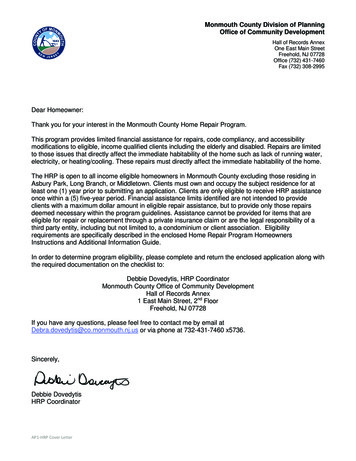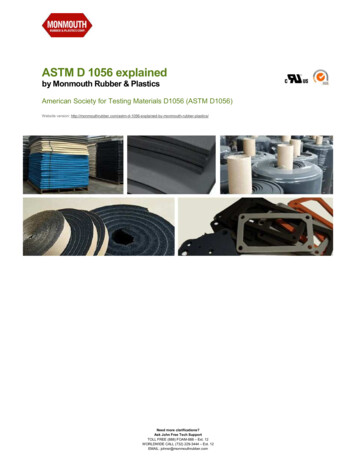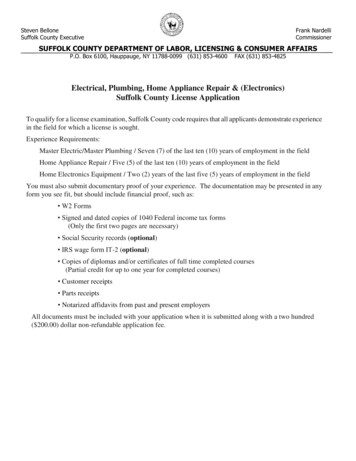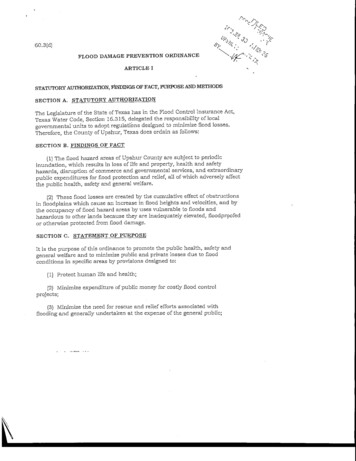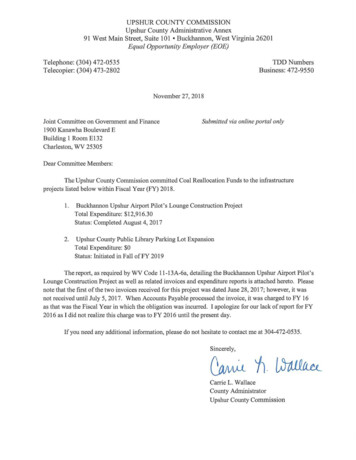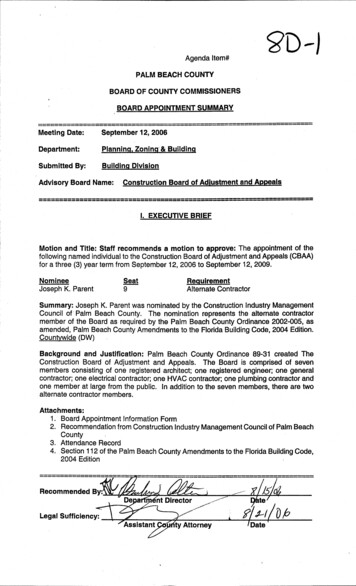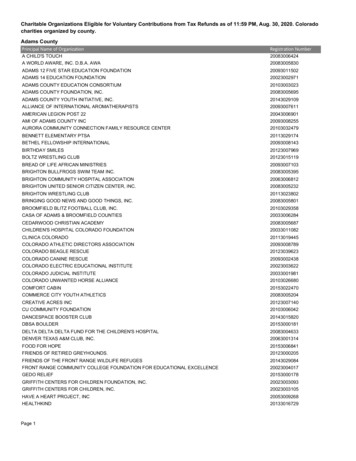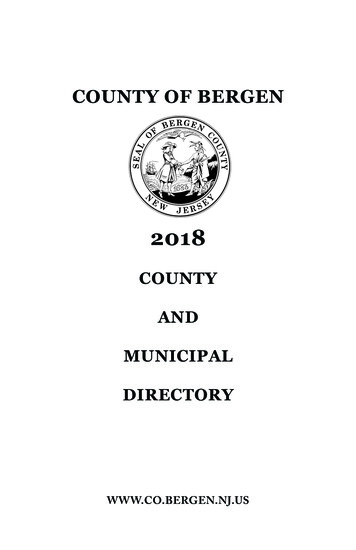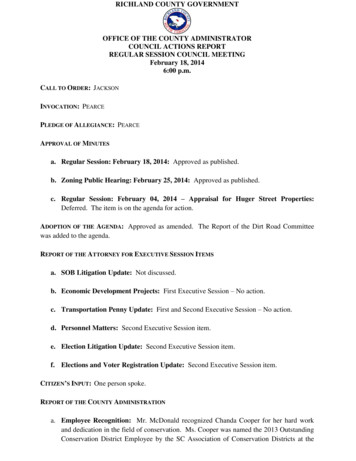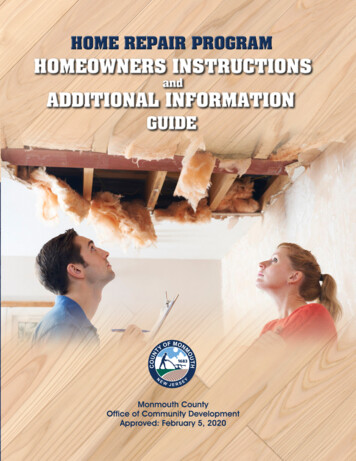
Transcription
The Monmouth County Home Repair Program(HRP)Homeowner’s Guide and Additional Information GuideSponsored By:Monmouth County Board of Chosen FreeholdersThomas A. Arnone, DirectorSusan M. Kiley, Deputy DirectorLillian G. BurryPat ImprevedutoNick DiRoccoProgram Administrator:Division of PlanningOffice of Community DevelopmentApproved: February 05, 2020 / April 01, 2020 Income Limits Standards
Table of ContentsChapter 1EligibilityA. Program EligibilityB. Program Income Limits ScheduleC. Eligible UnitsD. Ineligible UnitsPage 3Page 3Page 4Page 4Chapter 2Permitted Repairs by CategoryA. MajorB. MinorC. Barrier FreeD. Financial Assistance Limits for Eligible RepairsPage 4Page 5Page 6Page 6Chapter 3Program ParticipationPage 6Chapter 4Application RequestPage 6Chapter 5Application Review and Determination of EligibilityA. Household IncomeB. Unit EligibilityC. Property StatusD. Flood InsuranceE. HUD Lead Safe Housing RulesF. HRP Approval/DisapprovalPage 8Page 9Page 9Page 9Page 10Page 10Chapter 6Scoping and Approving the RepairPage 10Chapter 7Obtaining Three Contractor QuotesPage 11Chapter 8Award of ContractPage 13Page 1 of 16
Chapter 9Property Conditions and Client ProvisionsPage 13Chapter 10General Contract ProvisionsPage 14Chapter 11Warranty of WorkPage 15Chapter 12Materials, Methods and RestrictionsPage 15Chapter 13Project ClosurePage 16Page 2 of 16
PURPOSEThe Monmouth County Home Repair Program (HRP) provides limited financial assistance for repairs,code compliancy, and accessibility modifications to eligible, income qualified Homeowners includingthe elderly, and disabled. Repairs are limited to those issues that affect the habitability of the homesuch as lack of running water, electricity, or heating/cooling. These repairs must directly affect theimmediate habitability of the home.Chapter 1 - EligibilityA. Program EligibilityThe HRP is open to all income eligible Homeowners in Monmouth County excluding those residingin Asbury Park, Long Branch, or Middletown. Applicants may only receive HRP assistance oncewithin a five-year period. Assistance cannot be provided for items that are eligible for repair orreplacement through a private insurance claim or are the legal responsibility of a third party entitysuch as a condominium or homeowner association. Applicants must own and occupy the subjectresidence for at least one-year prior to making application. Eligibility Requirements are morespecifically described below.During the applications review process, the application will also be considered for eligibility forother housing programs administered by the Office of Community Development.B. Program Income LimitsAssistance is provided to applicants who meet Department of Housing and Urban Development(HUD mandated low and moderate-income standards. Determination of eligibility is based on thetotal gross annual household income based on household size in accordance with HUD’s incomestandards. The combined income of all adult household members is used to determine programeligibility. Income qualification is required, even if the applicant is certified as disabled or elderly.Households must have incomes that fall below the following annual income guidelines chartDepartment of Housing and Urban Development (HUD) income limits as of April, 01, 2020.Family Size12345678Income 54,950.00 62,800.00 70,650.00 78,500.00 84,800.00 91,100.00 97,350.00 103.650.00Note: Income Standards are subject to change annually. Please verify with the Office of CommunityDevelopment that you have the most current schedule.Page 3 of 16
C. Eligible Unit1) Owner occupied dwelling units only.2) For a duplex unit, only the owner occupied unit is eligible (except for shared commonappurtenances such as a roof or heating unit.)3) The home must be the primary residence of the owner.D. Ineligible Units1) Second homes, investment properties and/or vacation homes and the like are excluded.2) Units are not eligible for improvement if they are listed or advertised “for Sale” or “undercontract” for sale.Chapter 2 – Permitted Repairs by CategoryThe Program offers repairs that are categorized as follows; A. Major, B. Minor, and C. Barrier Free. Assistance through this program is provided to address specific repairs and/or replacementsinvolving faulty, defective, non-code compliant, or imminently hazardous home situation orto prevent further deterioration from occurring that would later require more extensiverepairs. It is not to be used for cosmetic improvements or to provide a higher level ofreplacement. Assistance through this program is provided to address specific repairs and/or replacementsand modifications to allow persons with disabilities to function more independently. The program is not to be utilized for cosmetic improvements including but not limited to: 1)interior or exterior painting; 2) floor covering material such as carpet, vinyl, tile orhardwood The assistance does pertain to necessary repairs to the subfloor and/or joists; such asrepairs to a floor that is sagging. Major and Minor repairs are limited to one specific component of the home and notintended to cover multiple unrelated repairs. For example: if the repair is a windowreplacement that would be one specific component with the window and trim would be theapproved components of the repair.Specific types of repairs are as follows:A. Major RepairsMajor repairs are intended to remedy emergency housing conditions which could pose a risk tothe health and/or safety of occupants. Examples of major types of repairs may include but arenot limited to: Faulty or inadequate heating/cooling systems ;Unsafe electrical systems;Inoperable plumbing systems including:o Lack of hot and cold running watero Inoperable water heatero Failing sanitary sewage systemPage 4 of 16
o Failing well or septic systemso leaking or ruptured waterlines1) Electrical systemso Lack of electricity;o Exposed or dangerous electrical wiring; Structural deficiencies posing an immediate threat to health or safety; Includes incidental repairs related to a major system replacement or repair.B. Minor RepairsMinor repairs are intended to prevent further deterioration of structures or systems which, ifnot corrected, could eventually lead to more extensive and/or major repair work Examples ofminor types of repairs may include, but are not limited to:1. Carpentry; Inoperable or damaged windows and doors; Minor home repairs to prevent further deterioration; Interior walls, ceilings and drywall; Other small carpentry repairs;2. Plumbing and associated fixtures such as sinks and toilets;3. Concrete such as outdoor concrete porches, stairs and private walkways;4. Roofing; Roof Leaks; Severely deteriorated or rotting roof material; Gutters;5. Electrical; Circuit breaker panel; Switches; GFI outlets/code compliance;o Smoke and/or carbon monoxide detectors.C. Barrier Free AccommodationsFor the purpose of this program, any combination of barrier free modifications listed below isconsidered (1) Minor Repair. Barrier free modifications allow persons with disabilities tofunction more independently. Modifications include but are not limited to: Wheelchair ramps; Stair Lifts and Platforms; Bath modifications; Widening of doorways to accommodate wheelchairs; Lowering of household fixtures such as cabinets and light fixtures; Grab bar installation.Exception –Stair lifts, platforms, and bath modifications qualify as (1) One Major RepairPage 5 of 16
The Project Manager will determine the need for, type, and category of repair during the initialinspection. They will also prioritize repairs based on health and safety first, with secondaryconsideration given to efficiency and other factors. All repairs and installations become theresponsibility of the homeowner upon project completion.D. FINANCIAL ASSISTANCE LIMITS FOR ELIGIBLE REPAIRSFinancial assistance limits are not intended to provide Homeowners with a maximum dollaramount in eligible repair assistance by category, but rather, to provide only those repairsdeemed necessary within the program guidelines.Homeowners may not apply for more than one of the following (1) repair categories: One (1) major repair not to exceed 10,000 orMinor repairs not to exceed 5,000 orBarrier Free accommodations are not to exceed 5,000.00, unless authorized for a stairlift, platform, or bath modification.Chapter 3 – Program ParticipationA. Program participation guidelines are as follows:1) Clients must own and occupy the subject residence for at least one (1) year prior tosubmitting an application.2) Financial assistance limits identified above are not intended to provide clients with amaximum dollar amount in eligible repair assistance, but to provide only those repairsdeemed necessary within the program guidelines.3) Applicants are not eligible to re-apply in the Home repair Program within five (5) yearsof a project closeout.B. Rehabilitation Standards1) Rehabilitation standards used in the Monmouth County Housing Repair Program is theNew Jersey Department of Community Affairs Rehabilitation Subcode. The Subcode isincorporated herein by reference.Chapter 4 – Application RequestA. Request an application:Please contact the Monmouth County Office of Community Development to request anapplication. Written requests to:Attn: Home Repair ProgramOffice of Community DevelopmentHall of Records Annex1 East Main Street, 2nd FloorFreehold, NJ 07728Page 6 of 16
E-mail requests to:homerepair@co.monmouth.nj.us Phone requests to:732.431.7460 Fax requests to:732.308.2995B. Required Documentation for Application SubmittalThe application packet will include a cover letter explaining the assistance process and a checklist. Applicants and co-applicants are to complete and sign the application jointly.The following information/documentation must be included with the application to confirmprogram eligibility:1) Applicant/Co-Applicant Information;2) Marital Status;o If married, a copy of the marriage certificate;o If divorced, a copy of the divorce decree;o If widowed, a copy of the spouse’s death certificate;3) Additional Related and Unrelated Household Members;4) Income & Employment Data – Provide the following that apply:o Copies of the last two years Federal income tax returns for all household;members 18 years of age or older. Tax returns must include all schedules andattachments. Those not required to file a Federal income tax return, must submita notarized copy of the Affidavit of Non-Filing included in the application packet;o Copies of the last four paystubs for each employed household member 18 yearsof age and older. Also include a Verification of Employment form (VOE) fromeach employer;o Verification of employment form (VOE) from each employer;o Copies of most recent Social Security benefit award letter(s);o Copies of most recent pension benefit award letter(s);o Any household member collecting unemployment must provide documentationfrom the NJ Department of Labor related to the individual’s claim;o Any household member 18 years of age or older not receiving income must submit anotarized Affidavit of Zero Income, included in the application packet;5) Property Information, to be verified by the Office of Community Development;o Address;o Block and Lot;o Current mortgage statement or letter from mortgagee;o A copy of recently paid utility bill ;Page 7 of 16
o Property tax statement from the municipality;6) Repair(s) requested to be verified through property inspection;7) Household Demographic Information (optional);8) Homeowners’ Insurance, proof that coverage is current and in effect;9) Proof of Flood Insurance coverage in accordance with 24 CFR 58.6;10) Certification of Accuracy and Completeness, signed;11) Lead Based Paint Receipt, signed;12) Privacy Act, signed; and13) Affidavit of Policy Guidelines signed and notarized.Homeowners shall be notified if their application is either incomplete or missing requireddocumentation. The Office of Community Development cannot provide assistance until allinformation that is required as part of the application is submitted and deemed complete.C. Return the Application:Return the completed, signed, and dated application to:Attn: Home Repair ProgramMonmouth County Office of Community DevelopmentHall of Records Annex1 East Main Street, 2nd FloorFreehold, NJ 07728Chapter 5 – Application Review and Determination of EligibilityUpon receipt of the application and all required documentation, the Housing Repair Coordinator shallreview the submission and shall determine the eligibility of the repairs/replacement being requestedas follows:A. Household Income:1) The applicant’s income shall be calculated to determine the total gross householdincome for the upcoming twelve (12) months. Determination of income eligibility shallbe in accordance with the HUD income guidelines. If determined ineligible, applicantsmay re-apply six (6) months after the determination of ineligibility.2) Generally, estimated gross annual income figures shall be based on income reported tothe IRS. Income includes but is not limited to wages, salaries, tips, commissions,alimony, overtime, pensions, social security, unemployment compensation, AFDC,disability, net income from business or real estate, and income from assets such assavings, CDs, Money Market, Mutual Funds, stocks, and bonds.Page 8 of 16
B. Unit eligibility:The HRP Coordinator shall verify the following:1) Property ownership through the Monmouth County Clerk’s Office by conducting a deedsearch. A copy of the deed shall be placed in the applicant’s file.2) For mobile homes, a copy of the motor vehicle title and a copy of the mobile park rentalagreement, both of which shall be placed in the applicant’s file.3) The property is located in an eligible municipality as identified on the applicant’s deed, notthe application.4) The property is the applicant’s primary residence as identified in the documentationsubmitted with the application (e.g. utility bill, benefit letters, tax returns, etc.).The property is not listed or advertised ‘for sale’ either ‘by owner’ or on a multiple listing service(MLS) website.C. Property Status:The HRP Coordinator shall verify that the property is properly insured and not at risk offoreclosure by:1) Confirming that the current mortgage statement(s) indicate all payments are current.2) Confirming with municipal officials that property tax, water, and sewer payments arecurrent. Property taxes must not be delinquent for any tax year unless the Homeowner hasentered into a written agreement with the taxing authority outlining a payment plan fordelinquent taxes and is abiding by the written agreement.3) Confirming through insurance declaration page that the Homeowners insurance on theproperty is current and in effect.D. Flood InsuranceFlood insurance is required for properties located in a special flood hazard area (SFHA) asidentified on the Flood Insurance Rate Maps (FIRM) that is in effect for the community theproperty is located in. The HRP Coordinator shall verify flood insurance applicability usingFEMA’s online FIRM Address Lookup -data/what-is-my-bfe-address-lookuptool/current effective FEMA1) SFHA Zone V/VE: An area of high flood risk subject to inundation by the 1% annual-chanceflood event with additional hazards due to storm-induced velocity wave action (a 3-foot orhigher breaking wave).2)SFHA Zone A/AE: An area of high flood risk subject to inundation by the 1% annual-chanceflood event.Page 9 of 16
3)SFHA Zone AO: An area of high flood risk subject to inundation by 1% annual-chanceshallow flooding where average depths are between one and three feet.4)Non-SFHA Zone X: Areas of low flood risk outside the 1%- and 0.2%-annual chancefloodplains.Where flood insurance is required, the applicant must provide proof that existing coverageexceeds the cost of repairs anticipated through the HRP.E. HUD Lead Safe Housing RulesFederally funded rehabilitation assistance of requires pre-1978 property units to be evaluatedby a risk assessment and all lead hazards must be addressed by interim controls using lead safework practices. Interim control measures will be evaluated on a case by case basis to determineif the financial feasibility of the project affects program eligibility. The Project Manager willconduct a lead risk hazard assessment for the proposed scope of work to determine t35www.hud.gov/sites/documents/DOC 12347.pdfF. HRP Approval/Disapproval If Approved: The HRP Coordinator will notify the Applicant by both mail and e-mail (ifavailable) to inform them that a Project Manager will be contacting them to arrange a homeinspection. If Disapproved: The HRP Coordinator will notify the Applicant by both mail and e-mail (ifavailable) that the application has been disapproved. The correspondence to the Applicantwill outline the reasons for disapproval and ways to rectify eligibility if possible. The HRPCoordinator will then close the file.Note: The Office of Community Development reserves the right to close any file that remainsinactive for a period of 30 days or longer.Chapter 6 – Scoping and Approving the RepairThe assigned Project Manager (PM) shall schedule an appointment with the Applicant to conduct aninitial inspection to evaluate the request for assistance which includes evaluation of the following: Determination of the actual need and scope for the home repair requested; Designation of the appropriate category of repair (Major, Minor, or Barrier Free) based uponestimated costs, materials, skills and/or amount of labor necessary to complete the scope ofwork.Based on the estimated cost, the PM will initiate and coordinate the lead hazard riskassessment per HUD 24CFR Part 35.The financial feasibility of repairs within the limits of the Home Repair Program. Page 10 of 16
Note: HRP may not be used to refinance repairs or improvements already in progress orcompleted.1) During the appointment, the PM will provide the applicant with a verbal overview of theHousing Repair Program. The client’s participation in gathering the quotes and the basic stepsinvolving the repair process will be discussed in detail. The PM will advise Homeowner oftheir responsibility to pay for any and all costs in excess of the approved HRP financialassistance limits.2) If the PM determines the proposed repair(s) meets program criteria, they will proceed tocreating the written Scope of Work. The PM will also provide additional verbal informationand instructions helpful to the client in preparation of the repair such as pre-constructiontasks (e.g. relocating personal items, cleaning and preparing, providing unobstructed access,and disclose anticipated time frames relating to the specific work.)3) If the PM determines the proposed repair(s) do not meet program criteria, they will perform acursory inspection of the residence to see if any initially unidentified repairs could qualify forthe program.4) Following the cursory inspection, if the PM is able to identify eligible repairs, then she/he willdraft a detailed report for the file explaining the findings on the premises. Pending theApplicant’s approval, the PM will proceed to the cost estimate process. (or)5) Following the cursory inspection, if the PM is unable to identify eligible repairs, then they willdraft a detailed report for the file explaining the findings on the premises. The HRPCoordinator will then notify the Applicant by both mail and e-mail (if available) the reasonwhy proposed ‘Scope of Work’ is ineligible under the guidelines of the Home Repair Program.The HRP Coordinator will then close the file.Note: From This point forward, The Applicant is now a Client of the Home Repair Program.Chapter 7 – Obtaining Three (3) Contractor QuotesThe Project Manager will instruct the Homeowner that they must obtain quotes from at least three (3)qualified contractors
B. Rehabilitation Standards 1) Rehabilitation standards used in the Monmouth County Housing Repair Program is the New Jersey Department of Community Affairs Rehabilitation Subcode. The Subcode is incorporated herein by reference. C
